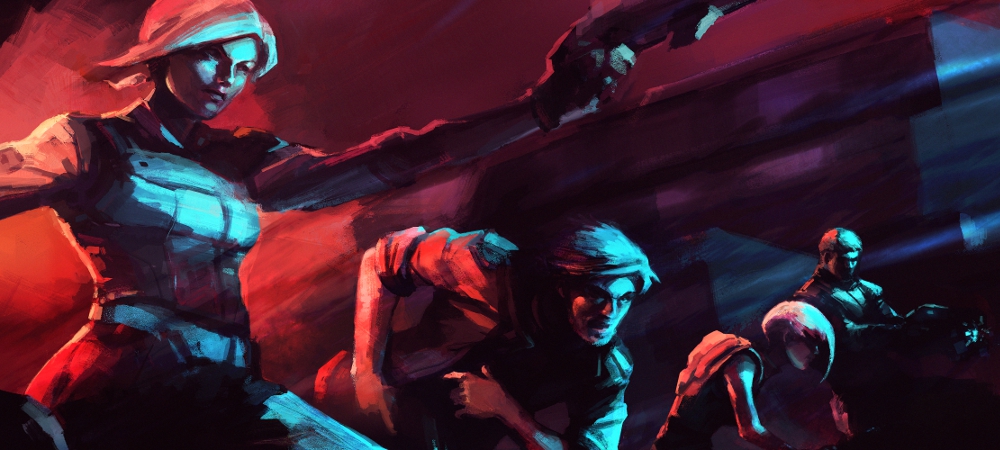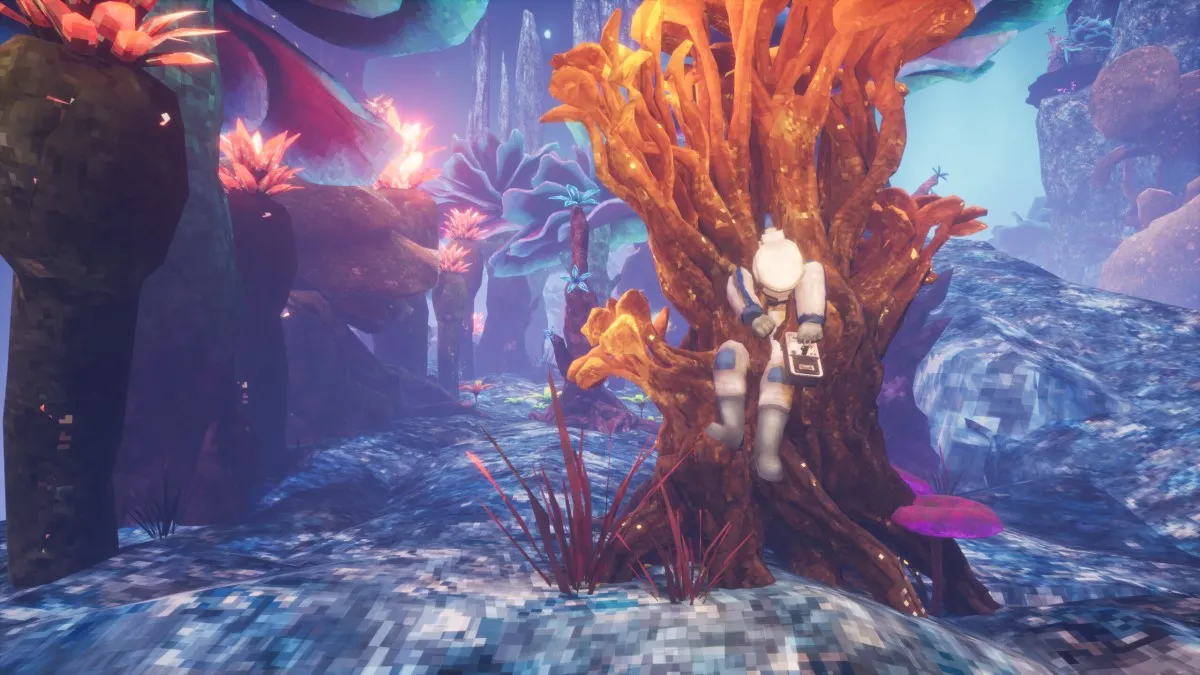Say it again, Sam
[Disclosure: I backed There Came an Echo on Kickstarter.]
Iridium Studios started out as a tiny developer with a humble Kickstarter for its rhythm role-playing game Sequence. It saw enough success that lead designer Jason Wishnov was able to fill out his team and spend more time taking on a much larger project.
Four years later, There Came an Echo is finally out. Though it plays nothing like the studio’s previous project, the two do share some striking similarities. Both are built on a neat idea, both explore themes of morality in science fiction, and both are a little rough around the edges.

There Came an Echo (PC [reviewed], Xbox One)
Developer: Iridium Studios
Publisher: Iridium Studios
Released: February 24, 2015
MSRP: $14.99
Rig: AMD Phenom II X2 555 @ 3.2 GHz, with 4GB of RAM, ATI Radeon HD 5700, Windows 7 64-bit
The main selling point of There Came an Echo is its real-time strategy gameplay facilitated by voice control. Taking on the role of the mysterious (and androgynously named) Sam, the player oversees the battlefield from an isometric perspective, issuing commands to the units fighting on the ground.
At first, the tactical considerations are light: friendly units should stay behind cover and flank enemies for maximum success. Each of the four characters carries a standard pistol, but eventually new weapons become available for the team to spread around. These add another layer to the combat tactics. The Charge gun deals area-of-effect damage, the Screw gun lays down suppressing fire, the Sniper rifle deals high damage at long range, and the Rail gun deals high damage with a high energy cost.
Each of the special weapons takes some amount of energy to fire, and that energy functions not only as ammunition, but also as shields. Once a shield drops to zero that unit is incapacitated until revived by a nearby teammate. This sets up a series of risk/reward decisions to make during each battle. Using special weapons recklessly can drain energy to the point where a few shots can take that unit down, but not using special weapons in the right situations can allow enemies to deal more damage than they otherwise would.
The different scenarios across the campaign keep combat fresh. Some are frantic, putting the heroes in the middle of a frenzied battle, and others are methodical, allowing time for Sam to survey the battlefield, set plans, and execute. Stealth comes into play during a few moments, and players get to set up the always satisfying “coordinate two units to shoot two unaware enemies simultaneously in order to avoid detection” maneuver.
Though There Came an Echo is most often described by its gameplay hook, it turns out the story is given almost as much attention. Over the course of the four-hour campaign, it felt like 40 percent of the time was spent listening to dialogue through in-engine cutscenes. For the most part, this isn’t bad. A lot of the writing is sharp and funny, though a few lines intended for laughs fall flat.
The plot shares some similarities with The Matrix, complete with the opening scene of an unknown caller guiding the reluctant hero out of an office building while men in suits try to kidnap him. Like The Matrix, There Came an Echo walks a line between providing thought-provoking questions about humans’ increasing technological prowess and ham-handed science fiction mumbo jumbo. Like The Matrix Revolutions, it crosses that line a few times.
The narrative is also perhaps a bit too self-indulgent for its own good. About halfway through there is a big reveal presented as a shocking twist, but only a select few will really feel the gravity of it. It’s difficult to discuss without treading too far into spoiler territory, but I can say even as a member of the target audience for the reveal, it took me a while to grasp the significance. To be fair, it is a pretty cool secret to keep throughout development, but that coolness will be lost on a lot of players.

The technology underlying There Came an Echo has always been impressive. The voice recognition is superb; the only issues I had with it came during heated battles when I was trying to get too many commands out too quickly. Not only does it recognize the preset words and phrases well, but it also allows players to input their own. No recording is necessary, just a typed word. I changed my phonetic alphabet to be names of famous scientists, and it worked with no trouble.
One of the hidden benefits of the voice control scheme is it helps to suspend disbelief. The fourth wall is more easily penetrated when the player is asked only to pretend to be a person sitting at a computer, giving battlefield commands from a remote location. It adds a more human element to a type of media best known for mouse clicks and button presses. Though the things happening on screen are not real, the voice connection between player and character helps to convince the brain it just could be.
Some special care was taken with the player’s dialogue to make the characters feel human. If an unwise or redundant order is given, the fighters will let Sam know. Near the beginning, the character Val asks the player to “say ‘hi,’ Sam.” Like any predictable cheeseball, I said “Hi, Sam,” to which Val responded with a sarcastic, “Very funny.”
Voice control is optional, but I couldn’t image wanting to play without it. My favorite battle moments stemmed from its use. There is the inherent nerdy fun of using a phonetic alphabet. There is the fluster that comes with taking on a more realistic commander role in a tense combat situation. The most enjoyment I got out of There Came an Echo‘s battles were with a series of rooms to clear with time to breathe in between. The system allows players to set up a long queue of commands set to different marks. After careful thought, planning, and instruction, executing it all with a few numbered “mark” commands is quite satisfying.

One drawback of the voice control is that the pared-down design can instill a sense of powerlessness. Ordering units to specific named locations works well, but not every location is designated. A few times near the beginning, I wanted to unit to be in a particular spot to flank an enemy, but there was no command to get him there.
Other technical issues showed up over the course of the game. The team at Iridium has been working up through release to clear out bugs, but I still found a few, including one that is locking me out from being able to use the Screw gun in the War Room — There Came an Echo‘s story-independent skirmish mode.
The War Room itself is a welcome addition, but it doesn’t feel like it goes as far as it should. It lets players defend against waves of enemies in a simple, symmetrical arena. At that, it functions fine, but I can’t help but wish for a greater variety of maps, more interesting objectives, or perhaps even some player-vs.-player action.

Aesthetically, There Came an Echo has its ups and downs. The environments are visually interesting: detailed, vibrant, and clear. The character models and animations don’t hold up quite so well, with robotic movement betraying the otherwise convincing human characters. The sound design is fantastic. Jimmy Hinson and Ronald Jenkees provide a great soundtrack to the sci-fi adventure. The voice cast does a good job bringing the characters to life, though there are a handful of cringe-worthy hammed up lines scattered throughout.
Overall, There Came an Echo is a worthy experience, but it’s lacking in too many minor areas to achieve greatness. While the voice-controlled strategy gameplay is engaging, it does lead to some design hiccups. While the narrative is entertaining and even intellectually demanding at times, it just as easily falls into navel-gazing jargon. While the technology is impressive, it feels like it belongs in a much bigger game.
The proof of concept is here, and I would certainly look forward to a hypothetical There Came an Echo 2 if it were announced. The groundwork has been laid, and with more content and finer polish it could be great. But knowing Iridium, the studio’s next project will be something completely different, taking its science fiction stories into another unusual genre mashup.
[This review is based on an advance backer copy of the game purchased by the reviewer.]





Published: Feb 24, 2015 02:00 am